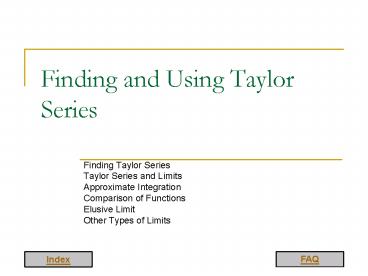Finding and Using Taylor Series - PowerPoint PPT Presentation
1 / 23
Title:
Finding and Using Taylor Series
Description:
Index. FAQ. Finding and Using Taylor Series. Finding Taylor Series. Taylor Series and Limits ... Taylor Polynomials at x=a. The Binomial Series. 1. 2. 3 ... – PowerPoint PPT presentation
Number of Views:48
Avg rating:3.0/5.0
Title: Finding and Using Taylor Series
1
Finding and Using Taylor Series
- Finding Taylor Series
- Taylor Series and Limits
- Approximate Integration
- Comparison of Functions
- Elusive Limit
- Other Types of Limits
2
Summary Formulae
Taylor Polynomials at xa
Maclaurin series Taylor series at x 0.
Basic Maclaurin series
1
Formulae 1 3 can be used for all x.
2
3
The Binomial Series
Valid only if -1 lt x lt 1.
3
Error Estimates
For alternating Taylor or Maclaurin series, use
the error estimates for alternating series.
This number L usually depends on x.
Error when Approximating the Function f with its
Taylor polynomial of degree m
Error Estimate
4
Overview of Problems
1
2
3
4
5
5
Overview of Problems
6
7
8
Decide which of the above functions takes the
smallest values and which the largest values for
small positive values of x.
6
Overview of Problems
9
- Compute f(1), f(0.1), f(0.01) and f(0.001) with
a mathematics program or a calculator. What can
you deduce of the limit of f(x) as x ? 0? - Plot the graph of the function f. What does the
graph suggest about the limit of f(x) as x ?
0? - Using Taylor series at x 0, compute the above
limit.
10
7
Finding Taylor Series (1)
Problem
Solution
8
Finding Taylor Series (2)
Problem
Solution
9
Finding Taylor Series (3)
Problem
Solution
To determine the constant of integration C,
insert x 0 in the above equation to get C 0.
10
Finding Taylor Series (4)
Problem
Solution
11
Taylor Series and Limits (1)
Problem
Solution
12
Taylor Series and Limits (2)
Problem
Solution (part b)
13
Approximate Integration
Problem
Solution
Problem
Estimate the error of the approximation.
14
Error Estimates
Problem
Solution
15
Comparison of Functions (1)
Problem
Decide which of the above functions takes the
smallest values and which the largest values for
small positive values of x.
Solution
We solve the problem by comparing the Taylor
series at x 0 of the above functions. The
smallest power terms of the series determine the
behavior of the function near the origin.
Solution continues
16
Comparison of Functions (2)
Solution continues
17
Comparison of Functions (3)
Final Comments
18
Elusive Limit (1)
Problem
- Compute f(1), f(0.1), f(0.01) and f(0.001) with
a mathematics program or a calculator. What can
you deduce of the limit of f(x) as x ? 0? - Plot the graph of the function f. What does the
graph suggest about the limit of f(x) as x ?
0? - Using Taylor series at x 0, compute the above
limit.
Solution
Numeric computations with Maple give f(1) ?
1.183, f(0.1) ? 2.000, f(0.01) ? 3.333 and
f(0.001) undefined.
1
19
Elusive Limit (2)
Problem
- Plot the graph of the function f. What does the
graph suggest about the limit of f(x) as x ?
0? - Using Taylor series at x 0, compute the above
limit.
Solution (contd)
The graph of the function f is seen on the
right. Clearly this plot is not reliable at x
0.
2
20
Elusive Limit (3)
Problem
- Using Taylor series at x 0, compute the above
limit.
Solution (contd)
To understand the limit, we need to compute
Taylor series for the numerator and the
denominator. We use a computer mathematics
system here.
3
This limit can be computed by Maples command
limit. The problems with the graph and with
computing actual values of f arise from the
fact that the Taylor series starts with order 14
terms.
21
Other Types of Limits (1)
Problem
The simpler version of the above where c 0 is
a familiar problem that we have already solved by
a rewriting. Here the same trick will not work.
Solution
22
Other Types of Limits (2)
Problem
Solution
Now we use the assumption a b c 0.
23
(No Transcript)































